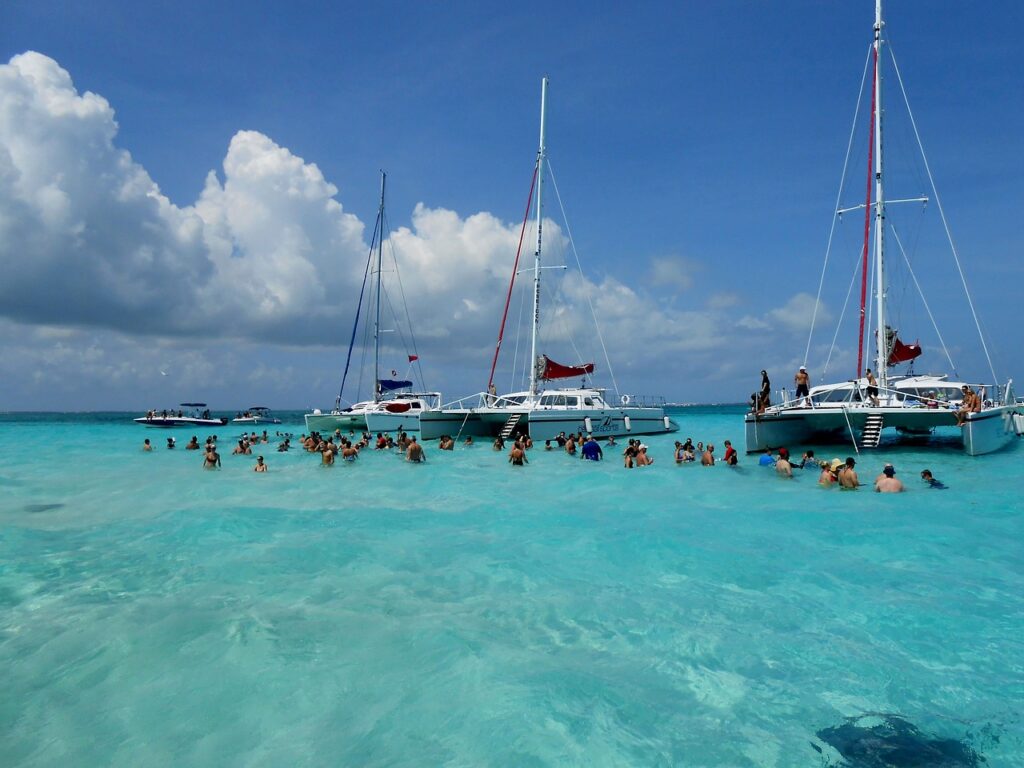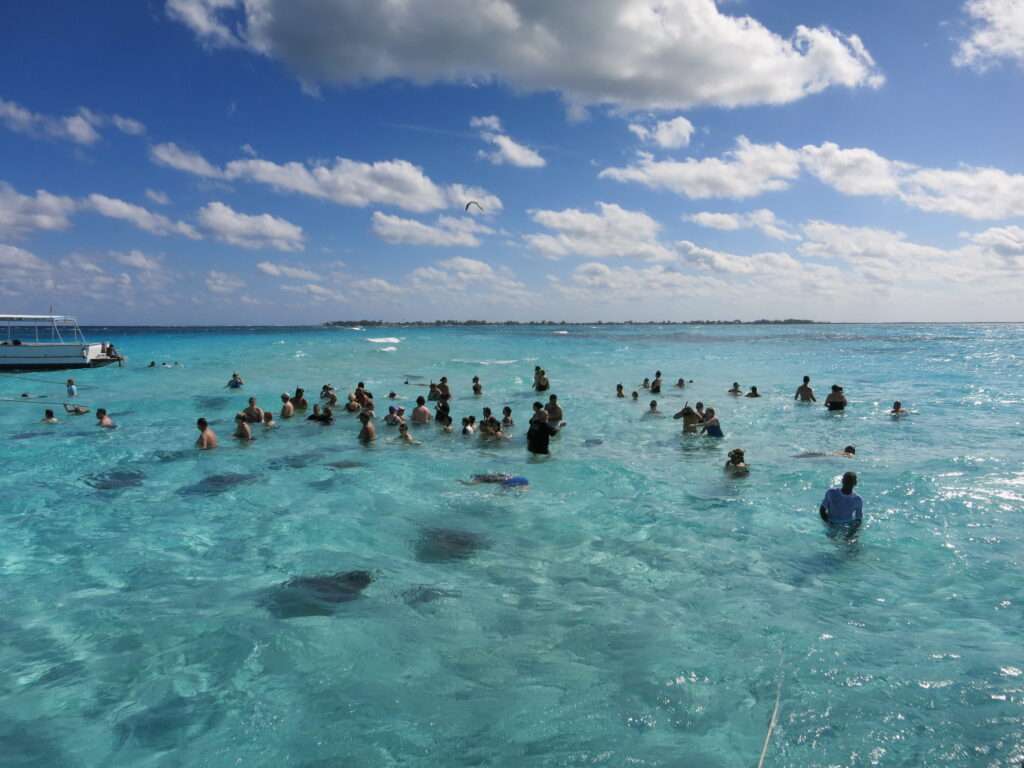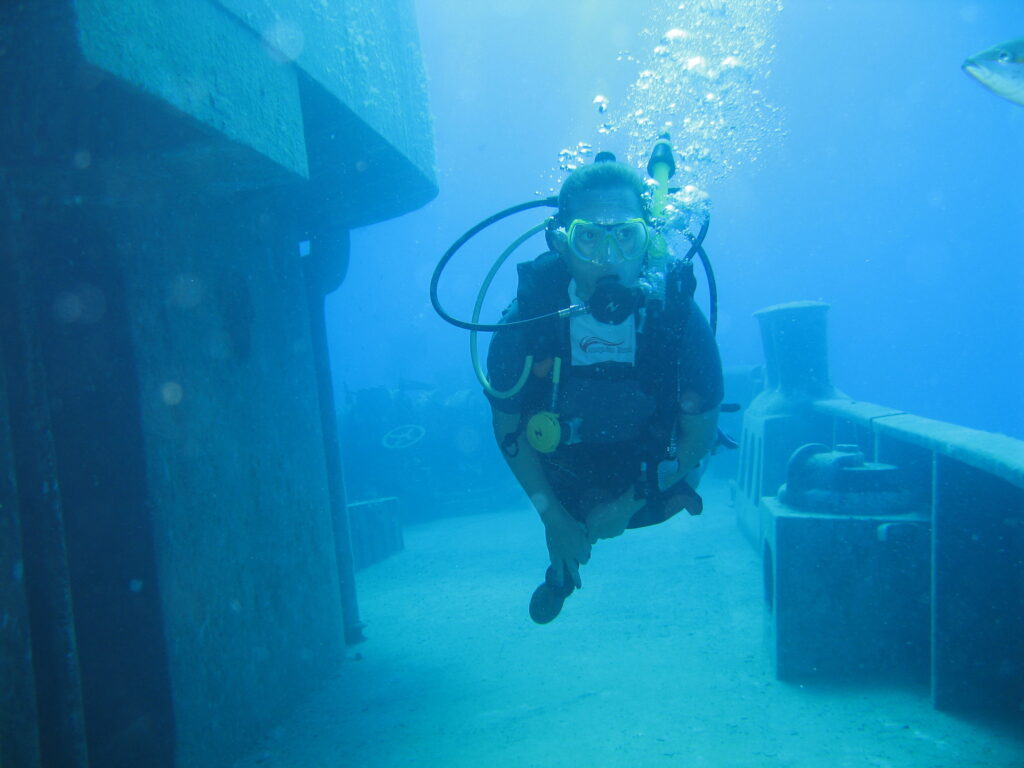Quick facts about Cayman Islands:
- Population: Approximately 65,000 people.
- Capital: George Town.
- Official Language: English.
- Currency: Cayman Islands dollar (KYD), pegged to the US dollar.
- Government: British Overseas Territory with a parliamentary democracy.
- Geography: A group of three islands in the Caribbean Sea, known for their stunning beaches, coral reefs, and rich marine life.
- Economy: Relies heavily on tourism, offshore banking, and financial services.
Fact 1: Despite its size, the Cayman Islands is a very popular tourist destination
Situated in the western Caribbean Sea, the islands consist of three main islands: Grand Cayman, Cayman Brac, and Little Cayman. Despite their compact landmass, they offer a wealth of attractions and activities for tourists, including world-renowned diving and snorkeling sites, such as Stingray City and the Bloody Bay Marine Park. Grand Cayman, the largest of the three islands, is particularly famous for its Seven Mile Beach, consistently ranked among the world’s best. The islands’ popularity can be attributed to their natural beauty, warm climate, and world-class amenities, making them a sought-after destination for travelers seeking relaxation, adventure, and luxury in the Caribbean.

Fact 2: The standard of living and cost of living in the Cayman Islands is very high
The Cayman Islands consistently rank among the wealthiest countries in the Caribbean region, with a prosperous economy driven primarily by tourism, financial services, and offshore banking. As a result, residents of the Cayman Islands enjoy a high standard of living, with access to modern amenities, high-quality healthcare, education, and infrastructure.
However, this affluence also translates into a high cost of living for both residents and visitors. The cost of goods and services in the Cayman Islands is notably higher than in many other countries, particularly for imported items. Housing, food, transportation, and entertainment expenses can be significantly more expensive compared to other destinations, reflecting the islands’ status as a luxury tourist destination and financial hub.
Fact 3: Seven Mile Beach is one of the most sought-after beaches in the Caribbean
Seven Mile Beach is a stunning stretch of powdery white sand that extends along the western coast of Grand Cayman, the largest of the three Cayman Islands. Its crystal-clear turquoise waters, gently sloping shoreline, and pristine beauty attract visitors from around the world.
The beach offers an array of amenities and activities, including water sports such as snorkeling, jet-skiing, and parasailing, as well as beachfront resorts, restaurants, and bars. Whether visitors seek relaxation, adventure, or simply the opportunity to soak up the sun in a picturesque setting, Seven Mile Beach delivers an unforgettable experience.

Fact 4: There’s a large population of turtles near the Cayman Islands
The waters surrounding the Cayman Islands are home to various species of sea turtles, including green turtles, hawksbill turtles, loggerhead turtles, and occasionally leatherback turtles. These turtles inhabit the coral reefs, seagrass beds, and coastal areas around the islands, where they feed on algae, seagrasses, and other marine organisms.
The Cayman Islands have implemented several conservation measures to protect sea turtles and their habitats, including marine protected areas, nesting beach monitoring programs, and regulations to prevent turtle poaching and harassment. As a result, the islands provide important nesting and foraging grounds for sea turtles in the Caribbean region.
Fact 5: The Cayman Islands are known for their offshore financial industry and duty-free shopping options
The Cayman Islands have established themselves as a leading offshore financial center, attracting businesses and investors from around the world due to their favorable tax and regulatory environment. The islands offer a range of financial services, including banking, investment management, insurance, and corporate services, making them a hub for international finance and commerce.
In addition to their offshore financial sector, the Cayman Islands are also popular for duty-free shopping. Visitors to the islands can take advantage of duty-free shopping opportunities at various retail outlets, including luxury boutiques, jewelry stores, souvenir shops, and more. Duty-free shopping allows travelers to purchase goods such as electronics, jewelry, watches, perfumes, and cosmetics at discounted prices, as they are exempt from local taxes and duties.

Fact 6: Cayman Islands a paradise for seafood lovers
Situated in the Caribbean Sea, the Cayman Islands boast rich marine biodiversity and pristine waters, providing an ideal environment for fishing and harvesting seafood. As a result, the islands offer an array of delicious seafood dishes that showcase the freshest catch of the day.
Seafood lovers visiting the Cayman Islands can indulge in a variety of culinary delights, including locally caught fish such as mahi-mahi, snapper, grouper, and wahoo, as well as shellfish like lobster, conch, and shrimp. These ingredients are often prepared using traditional Caribbean cooking techniques and infused with local flavors and spices, resulting in mouthwatering dishes that highlight the region’s culinary heritage.
Fact 7: You can swim with stingrays in the Cayman Islands
One of the most famous attractions in the Cayman Islands is Stingray City, where visitors have the unique opportunity to swim and interact with southern stingrays in their natural habitat. Located in the shallow waters of Grand Cayman’s North Sound, Stingray City is a sandbar where these gentle creatures congregate, attracted by the presence of fishermen who traditionally cleaned fish there.
Tour operators offer guided excursions to Stingray City, providing visitors with the chance to wade, snorkel, or swim in the crystal-clear waters alongside the stingrays. Guides typically provide educational information about stingrays and offer opportunities to feed, touch, and even kiss these fascinating marine animals.

Fact 8: Pirate Week is an annual event celebrated in the Cayman Islands
Pirate Week is a fun and festive celebration that pays homage to the Cayman Islands’ rich maritime heritage and history of piracy. The event features a variety of activities and entertainment, including pirate-themed parades, street festivals, costume contests, live music performances, fireworks displays, and more.
During Pirate Week, residents and visitors alike embrace the spirit of adventure and camaraderie, dressing up as pirates, mermaids, and other nautical characters to participate in the festivities. Highlights of the event often include mock pirate invasions, treasure hunts, pirate ship cruises, and reenactments of historical pirate encounters.
Note: If you plan to visit the islands, check if you need an International Driver’s License in the Cayman Islands to rent and drive a car.
Fact 9: It was the Cayman Islands that paved the way for diving
The Cayman Islands are celebrated for their pristine coral reefs, crystal-clear waters, and abundant marine life, making them a premier destination for scuba diving enthusiasts from around the world. Divers flock to the islands to explore iconic dive sites such as the famous walls of Grand Cayman, the vibrant coral gardens of Cayman Brac, and the diverse marine ecosystems of Little Cayman’s Bloody Bay Marine Park.
Cayman Islands have made significant contributions to the growth and development of recreational diving in the Caribbean, they are part of a larger global diving community that has collectively shaped the evolution of the sport. Diving pioneers and organizations from various countries have all played roles in advancing diving technology, training, safety standards, and awareness, contributing to the widespread popularity and accessibility of diving as a recreational activity.

Fact 10: The Cayman Islands are home to the critically endangered Grand Cayman blue iguana
The Grand Cayman blue iguana is a species of lizard endemic to the island of Grand Cayman in the Cayman Islands. Once on the brink of extinction, the population of these iguanas has been severely threatened by habitat loss, predation by invasive species, and other human-related activities.
Conservation efforts spearheaded by organizations such as the Blue Iguana Recovery Program have been instrumental in the recovery of the Grand Cayman blue iguana population. Through captive breeding, habitat restoration, and public education initiatives, these conservation programs aim to protect and preserve this unique species for future generations.

Published April 14, 2024 • 7m to read





